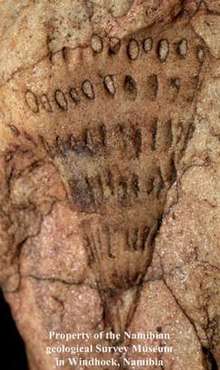Ausia (animal)
Ausia fenestrata is a curious Ediacaran period (630 – 542 million years ago) fossil represented by only one specimen 5 cm long from the Nama Group, a Vendian to Cambrian group of stratigraphic sequences deposited in the Nama foreland basin in central and southern Namibia.[1] It has similarity to Burykhia from Ediacaran (Vendian) siliciclastic sediments exposed on the Syuzma River of northern Russia.[2][3][4] This fossil is of the form of an elongate bag-like sandstone cast (Nama-type preservation) tapering to a cone on one end. Surface of the fossil is covered with oval depressions ("windows") regularly spaced over the surface in the manner of concentric/parallel rows. The taxonomic identity of Ausia is unresolved.
| Ausia Temporal range: Ediacaran | |
|---|---|
 | |
 | |
| Fossil and M. Fedonkin reconstruction of Ausia as sponge-like organism | |
| Scientific classification | |
| Kingdom: | Animalia |
| Phylum: | Chordata |
| Subphylum: | Tunicata |
| Class: | Ascidiacea |
| Genus: | †Ausia |
| Species: | †A. fenestrata |
| Binomial name | |
| †Ausia fenestrata Hahn and Pflug, 1985[1] | |

Hahn and Pflug reconstruction of Ausia as a pennatulacean
Interpretations
- G. Hahn and H. D. Pflug suggested that Ausia is a pennatulacean coral from the family Veretillidae, but there are no signs of secondary polyps on the fossil, which are nonetheless represented in Hahn and Pflug's reconstruction.[1] No veretillids are represented in the fossil record as far as is known.[5]
- Some researchers have assumed that these depressions are pores and interpreted Ausia as an ancestor of archeocyathans and other sponge-like organisms[3] or true sponge.[6] But Adolf Seilacher has argued that the "windows" are merely dimples.[6]
- Ausia may represent ascidians (sea squirts),[7] an invertebrate group related to the chordates.[4][8] Results of a new study of a Burykhia from Russia have shown a possible affinity of these organisms to the ascidians, which are urochordates. The Russian species is more than 90 mm across, and the rows of oval depressions are separated by structures which were probably grooves in the internal wall surface of the living organism. The study's authors interpret these fossils as the internal sand casts of a vast bag-like cavity, possibly a pharynx or branchial basket.[4] The animals represented by these two genera were thought to live in the shallow waters of an epicontinental sea, slightly more than 555-548 million years ago, and the authors feel this is probably the oldest evidence of the chordate lineage of metazoans.[4]
- Jerzy Dzik has suggested that Ausia bears some similarity to the halkieriids, and resembles the body plan that might be expected of halkieriid ancestors under the coeloscleritophoran hypothesis.[9][10]
gollark: Kind of.
gollark: Iff you were apioforms - which you are not.
gollark: Cryoapioform #26 disagrees.
gollark: Our antimemetics are really excellent.
gollark: (none can be spared)
See also
- List of Ediacaran genera
- Yarnemia, another Ediacaran thought to be a tunicate.
References

Reconstructed as a tunicate
- Hahn, G.; Pflug, H. D. (1985). "Polypenartige Organismen aus dem Jung-Präkambrium (Nama-Gruppe) von Namibia". Geologica et Palaeontologica. 19: 1–13.
- "IGCP 493 Annual Report 2003" (PDF). Archived from the original (PDF) on 2008-07-21. Retrieved 2008-11-20.
- M. A. Fedonkin (1996). "Ausia as an ancestor of archeocyathans, and other sponge-like organisms". In: Enigmatic Organisms in Phylogeny and Evolution. Abstracts. Moscow, Paleontological Institute, Russian Academy of Sciences, p. 90-91.
- M.A. Fedonkin, P. Vickers Rich, B. Swalla, P. Trusler, M. Hall. (2008). "A Neoproterozoic chordate with possible affinity to the ascidians: New fossil evidence from the Vendian of the White Sea, Russia and its evolutionary and ecological implications". HPF-07 Rise and fall of the Ediacaran (Vendian) biota. International Geological Congress - Oslo 2008.
- Gary C. Williams. "Aspects of the Evolutionary Biology of Pennatulacean Octocorals". Cite journal requires
|journal=(help) - Mark A. S. McMenamin (1998). "The Sand Menagerie". In: The Garden of Ediacara: Discovering the First Complex Life. Columbia University Press. New York. pp.11-46.
- Fedonkin, M. A.; Vickers-Rich, P.; Swalla, B. J.; Trusler, P.; Hall, M. (2012). "A new metazoan from the Vendian of the White Sea, Russia, with possible affinities to the ascidians". Paleontological Journal. 46: 1. doi:10.1134/S0031030112010042.
- Vickers-Rich P. (2007). "Chapter 4. The Nama Fauna of Southern Africa". In: Fedonkin M.A., Gehling J.G., Grey K., Narbonne G.M., Vickers-Rich P. The Rise of Animals: Evolution and Diversification of the Kingdom Animalia, Johns Hopkins University Press. pp. 69-87
- Dzik, Jerzy (August 2009). "Possible Ediacaran Ancestry of the Halkieriids" (PDF). In Smith, Martin R.; O'Brien, Lorna J.; Caron, Jean-Bernard (eds.). Abstract Volume. International Conference on the Cambrian Explosion (Walcott 2009). Toronto, Ontario, Canada: The Burgess Shale Consortium (published 31 July 2009). ISBN 978-0-9812885-1-2.
- Dzik, J. (2011). "Possible Ediacaran ancestry of the halkieriids". Palaeontographica Canadiana. 21: 205–218.
This article is issued from Wikipedia. The text is licensed under Creative Commons - Attribution - Sharealike. Additional terms may apply for the media files.